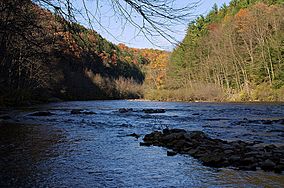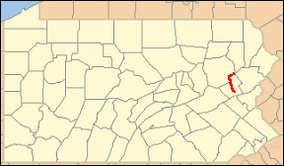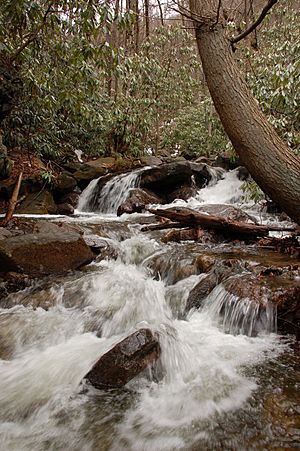Lehigh Gorge State Park facts for kids
Quick facts for kids Lehigh Gorge State Park |
|
|---|---|
|
IUCN Category V (Protected Landscape/Seascape)
|
|

At Lehigh Gorge State Park, Pennsylvania; Rockport access.
|
|

Location of Lehigh Gorge State Park in Pennsylvania
|
|
| Location | Pennsylvania, United States |
| Area | 4,548 acres (18.41 km2) |
| Elevation | 1,027 ft (313 m) |
| Established | 1980 |
| Named for | Lehigh Gorge |
| Governing body | Pennsylvania Department of Conservation and Natural Resources |
| Website | Lehigh Gorge State Park |
Lehigh Gorge State Park is a large state park in Pennsylvania, covering 4,548 acres (1,841 ha). It's located in Luzerne and Carbon Counties. The park protects the beautiful Lehigh Gorge, which follows the Lehigh River. This gorge stretches from a dam in Luzerne County all the way to Jim Thorpe in Carbon County. Many visitors come to Lehigh Gorge State Park for exciting white water rafting.
Contents
Getting to Lehigh Gorge State Park
You can enter Lehigh Gorge State Park from three main areas. Each spot offers different ways to start your adventure.
Northern Access Point: White Haven
The northern entrance is in White Haven. You can find it easily off exit 273 of Interstate 80 on Pennsylvania Route 940. This spot was once important for loading goods onto barges for the Lehigh Canal.
Central Access Point: Rockport
The middle entrance is near Rockport. It's a few miles off Pennsylvania Route 93 close to Weatherly. This area was also important for trains in the past.
Southern Access Point: Jim Thorpe
The southern entrance is near Jim Thorpe. Take exit 74 of Interstate 476 and then U.S. Route 209. Cross the bridge to the north bank on Pennsylvania Route 903. This area is close to the famous Glen Onoko nature and hiking trails.
The Lehigh River's Journey

The Lehigh River flows through the park, forming the border between Carbon and Luzerne counties in the northern part. The park begins just below the U.S. Army Corps of Engineers Francis E. Walter Dam.
The river flows south through several townships and towns. It passes through White Haven and East Side. Then it goes past Hickory Run State Park on its left side.
As the river continues south, it leaves Luzerne County and stays within Carbon County. It makes a big bend at Rockport, where the central access point is. The river then reaches Jim Thorpe and Nesquehoning. The park ends just above the Pennsylvania Route 903 bridge in Jim Thorpe.
Lehigh Gorge Trail
The Lehigh Gorge Trail is a popular path that follows the right bank of the Lehigh River. This trail is used for many activities. It stretches for 26 miles (42 km) through the park.
Park History
The story of Lehigh Gorge State Park is closely linked to the history of anthracite coal mining. This type of coal was very important for energy in Pennsylvania.
Early Coal Mining and Transport
In the late 1700s, people discovered high-quality coal in the area. This led to quick growth in coal mining. But moving the heavy coal was a big problem. Roads were often just muddy tracks, and wagons couldn't carry much. The best way to move large amounts of goods was by water.
By the early 1800s, companies started to build canals to make river travel easier. One important company was the Lehigh Coal & Navigation Company. They worked to improve the Lehigh River so that barges could carry coal.
Building Canals and Railroads
The Lehigh River had many fast-moving sections called rapids. These rapids made it hard for boats to pass. So, the company built dams and locks to create a smoother path for barges. This project was called the Upper Grand Section of the Lehigh Canal.
However, severe floods in the mid-1800s destroyed parts of the canal. After the floods, railroads became the main way to transport coal. Trains could move goods faster and were not affected by floods as much. A railway line was built through the gorge between 1852 and 1855.
Lumber Industry in the Gorge
In the mid to late 1800s, there was a huge demand for lumber. The forests of Lehigh Gorge, filled with white pine and hemlock trees, were cut down. The wood was used for building, and the tree bark was used to make leather in tanneries.
By 1875, most of the valuable trees were gone. A spark from a passing steam locomotive caused a huge forest fire that year. This fire burned the remaining trees and sawmills, ending the lumber era in the gorge.
From Resort to State Park
Around the early 1900s, Lehigh Gorge became a popular resort area. Railroads brought tourists to places like Glen Onoko. There was a hotel with 47 rooms, tennis courts, and trails to the beautiful Glen Onoko Falls. People came to escape the busy, polluted cities.
Sadly, the hotel and nearby forests were destroyed by fire in the 1910s. The Lehigh Gorge area was mostly forgotten for many years. In 1972, the main railroad line through the gorge was no longer used. The state of Pennsylvania bought this land. This led to the creation of Lehigh Gorge State Park in 1980, so everyone could enjoy its natural beauty.
Fun Activities in Lehigh Gorge State Park
Lehigh Gorge State Park offers many exciting ways to enjoy nature. You can go rafting, hiking, bicycling, or watch for animals and birds. The park is also open for hunting and fishing.
White Water Rafting
Rafting is a very popular activity here. The Lehigh River is known as a Class III river on the International Scale of River Difficulty. This means it has exciting rapids! The best time for rafting is usually in the spring. The water levels depend on rainfall and water released from the Francis E. Walter Dam.
Everyone on a boat must wear a life jacket that meets safety rules. Several companies offer guided rafting trips on the river.
Trails for Hiking and Biking
The Lehigh Gorge Trail is a 26 miles (42 km) long trail. It's great for hiking and bicycling all year round. This trail is also part of the larger 165 miles (266 km) D & L Trail. You can rent bicycles and get shuttle service if you need it.
In winter, the trail is perfect for cross-country skiing. A 15 miles (24 km) section is open for snowmobiles. Besides the main trail, there are also 7 miles of hiking-only trails. These trails are not marked, so be sure to explore carefully!
Hunting and Fishing Opportunities
Hunting is allowed in many parts of Lehigh Gorge State Park. Hunters must follow the rules set by the Pennsylvania Game Commission. You might find animals like ruffed grouse, squirrels, turkey, white-tailed deer, black bear, and rabbits. However, hunting groundhogs is not allowed.
For fishing, the Pennsylvania Fish and Boat Commission regularly adds trout to the Lehigh River. This means anglers have a great chance to catch fish!
Nearby State Parks
If you enjoy Lehigh Gorge State Park, you might also like these other state parks nearby:
- Beltzville State Park (Carbon County)
- Big Pocono State Park (Monroe County)
- Frances Slocum State Park (Luzerne County)
- Gouldsboro State Park (Monroe and Wayne Counties)
- Jacobsburg Environmental Education Center (Northampton County)
- Hickory Run State Park (Carbon County)
- Locust Lake State Park (Schuylkill County)
- Nescopeck State Park (Luzerne County)
- Tobyhanna State Park (Monroe and Wayne Counties)
- Tuscarora State Park (Schuylkill County)

